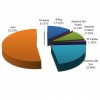Abstract
Este artículo provee información referente a las tendencias globales en cuanto a producción, comercio mundial y los países exportadores e importadores de papaya.
Written by Edward A. Evans and Fredy H. Ballen, and published by the UF Department of Food and Resource Economics, October 2012.
References
FAO. 2006. The Impact of Post-Harvest Handling Losses. http://www.fao.org/es/esc/common/ecg/227/en/
FAOSTAT. 2012a. Crop Production. http://faostat.fao.org/site/567/default.aspx#ancor
FAOSTAT. 2012b. Detailed Trade Data. http://faostat.fao.org/site/535/defalult.aspx#ancor
IBRAF (Brazilian Fruit Institute). 2012a. Brazilian Fruit Information for Consumers: Papaya. http://www.brazilianfruit.org/ingles/information_for_Consumer/consumer_papaya.asp?produto=7
IBRAF (Brazilian Fruit Institute). 2012b. Fresh Fruits Statistics. http://www.ibraf.org.br/estatisticas/est_frutas.asp (en portugués)
Mendoza, T., C. Laurena, and J. Botella. 2008. Recent advances in the development of transgenic papaya technology. Biotechnology Annual Review 14:423-462. https://doi.org/10.1016/S1387-2656(08)00019-7
SIAP (Mexican Agricultural Information Service). 2012. International Trade. http://www.siap.gob.mx/index.php?option=com_content&view=article&id=50&Itemid=380 (en español)
SIB (Statistical Institute of Belize). 2012. Statistics: External Trade. http://www.statisticsbelize.org.bz/dms20uc/dm_browse.asp?pid=4
The Hindu Business Line. 2011. Papaya: Introducing high-yield varieties key to healthy profits. http://www.thehindubusinessline.com/industry-and-economy/agri-biz/article2726583.ece
UN Comtrade. 2012. http://comtrade.un.org/

